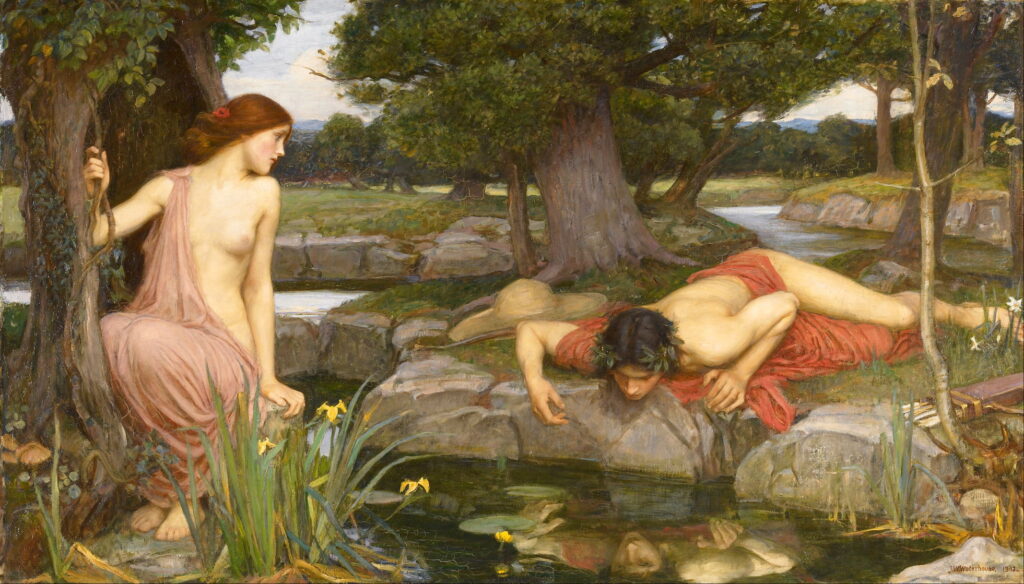Changing Paintings: 13 Echo and Narcissus

After Ovid has described the tragic deaths of Actaeon and Semele, and briefly mentioned the remarkable circumstances of the birth of Bacchus, he takes a break from the Theban cycle for the popular myth of Echo and Narcissus. He leads into that from an argument between Jupiter and Juno over sexual pleasure, taking the narrative to a short account of the bizarre life of Tiresias, and finally to the double myth of the nymph and her self-obsessed lover.
In an idle moment, Jupiter and his wife (and half-sister) Juno are arguing over whether the man or woman gets more pleasure from sex. This leads them to refer the matter to Tiresias, who had changed gender twice, and is therefore presumed to have experience on both sides of the bed. When a young man, he had disturbed a pair of snakes copulating, causing him to become female. Over seven years later, he chanced upon the same event, and by striking the snakes again reverted to being male.
Tiresias sides with Jupiter’s claim that the woman obtains greater pleasure than the man, so incurring Juno’s wrath. As his punishment for disagreeing with her, she blinds him. Because Jupiter is unable to reverse her vindictive act, he compensates the hapless Tiresias by giving him prophetic powers. Those become Tiresias’s claim to fame, and the link to the tragic fates of the young couple.
Narcissus was the son of the water-nymph Liriope, who had been raped and impregnated by the river-god Cephisus. When her son was young, his mother brought him to Tiresias for him to pronounce on his future. The blind seer responded true to form with cryptic words, saying that if he could avoid recognising himself, he would have a long life ahead of him.
Giulio Carpioni (1613–1678), Liriope Bringing Narcissus before Tiresias (c 1665), oil on canvas, 160 x 230 cm, Private collection. Wikimedia Commons.
Sadly, no one has risen to the challenge of depicting Tiresias’s gender changes, and only Giulio Carpioni has painted Liriope Bringing Narcissus before Tiresias (c 1665), as a young infant. This makes no reference to the prophecy or the child’s fate.
When Narcissus is approaching manhood at the age of fifteen, Echo falls in love with him. She is a nymph who had originally been too loquacious for Juno, who had transformed her powers of speech so that she could only repeat the words of others, as their echo.
Alexandre Cabanel (1823–1889), Echo (1874), oil on canvas, 97.8 x 66.7 cm, Metropolitan Museum of Art, New York, NY. Wikimedia Commons.
Alexandre Cabanel’s portrait of Echo from 1874 does a brave job of eliciting that acoustic phenomenon using an image of the nymph with her head against an acoustically reflecting surface of rock.
Ovid here uses his skills to illustrate this in some echoed exchanges between Narcissus and Echo, culminating in these words spoken as he flees her advances:
[Narcissus] Hands off! May I die before you enjoy my body!
[Echo] Enjoy my body!
Ovid then reveals the curse afflicting young Narcissus: one youth, whom he had scorned earlier, prayed that Narcissus should never be able to win his love, a bidding implemented by Nemesis. This became manifest when Narcissus, slaking his thirst in a lonely pool, first saw himself: that was the moment the young man fell in love with his own reflection, so becoming afflicted by narcissism.
Caravaggio (Michelangelo Merisi da Caravaggio) (1571–1610), Narcissus (1594-96), oil on canvas, 110 × 92 cm, Galleria Nazionale d’Arte Antica, Rome. Wikimedia Commons.
By far the most famous painting of Narcissus with just his beloved reflection is Caravaggio’s Narcissus of 1594-96. If there’s one painting that displays the virtues of masterly chiaroscuro, this is it.
Being unable to embrace his reflection, Narcissus pines for himself, and cannot eat or rest for his burning love for himself.
Johann Heinrich Tischbein (1722–1789), Narcissus (c 1770), oil on canvas, 32.5 x 39.5 cm, Museumslandschaft Hessen Kassel, Kassel, Germany. Wikimedia Commons.
The reflection in Johann Heinrich Tischbein’s Narcissus (c 1770) appears almost plausible until you study it carefully.
Jules-Cyrille Cavé (1859–1940), Narcissus (1890), oil on canvas, 99.1 × 198.1 cm, Private collection. Wikimedia Commons.
Jules-Cyrille Cavé’s Narcissus (1890) is unusual for placing him almost in a kiss with his reflection.
Echo follows him around, watching him being consumed by this passion for himself, until he lies down on the grass and says “Farewell!” Echo repeats his valediction, and Narcissus dies. Naiads then cut their hair to place on his body to prepare it for his funeral pyre, but when they aren’t looking it’s transformed into narcissus flowers.
Ludwig von Hofmann (1861–1945), Narcissus (c 1900), oil on canvas, 149.5 × 95.5 cm, Muzeum Narodowe w Warszawie, Warsaw, Poland. Wikimedia Commons.
Ludwig von Hofmann’s Narcissus from about 1900 captures Ovid’s echoing wordplay. Narcissus stoops, as if listening for the repetition of the end of his words from the near-mute Echo beside him. Von Hofmann was a contemporary of Lovis Corinth, painted with a not dissimilar style, and like him was a co-founder of the Berlin Secession.
Talbot Hughes (1869-1942), Echo (1900), oil on canvas, 66 × 119 cm, Private collection. Wikimedia Commons.
Talbot Hughes’ Echo (1900) reverses the more popular scene, with the nymph splayed across most of its foreground, surrounded by narcissus flowers, and the ghostly image of a man perhaps appearing in the waterfall at the top left, with its poignant reflection. Echo is in a rocky gorge, where we would expect to hear echoes, and holding her right hand cupped against her ear. She even wears narcissus flowers in her hair.
John William Waterhouse (1849–1917), Echo and Narcissus (1903), oil on canvas, 109.2 x 189.2 cm, Walker Art Gallery, Liverpool, England. Wikimedia Commons.
A couple of narcissus flowers are also to be seen at the far right edge of John William Waterhouse’s Echo and Narcissus (1903), which combines the young man staring longingly at his reflection, with the forlorn and near-mute figure of Echo stood at the left.
Nicolas Poussin (1594–1665), Echo and Narcissus (c 1630), oil on canvas, 74 x 100 cm, Musée du Louvre, Paris. Wikimedia Commons.
I suspect that Waterhouse was well aware of Nicolas Poussin’s justly famous Echo and Narcissus of about 1630, showing the final moments of Ovid’s story: Narcissus is asleep, nearing death, his flowers already coming into bloom beside his head. In the background, Echo looks mutely on, knowing that her love will remain unrequited. Cupid stands still, holding his torch, but his arrow points to the heavens.
The most complete account of this myth in its full context, though, is in Poussin’s slightly later masterpiece The Empire of Flora (1631).
Nicolas Poussin (1594–1665) The Empire of Flora (1631), oil on canvas, 131 × 181 cm, Gemäldegalerie Alte Meister, Dresden, Germany. Wikimedia Commons.
Among its figures are:
a herm representing Priapus, his phallus wreathed in the greenery of gardens and fertility;
Ajax, falling on his sword and his spilled blood turning not into a purple hyacinth but a white carnation;
Narcissus and Echo, the former enraptured by his own reflection, with Echo gazing longingly at him, and the narcissus flower (below);
Clytie, who fell in love with Apollo and pined away into the sunflower (heliotrope);
Apollo in his sun chariot, with a band containing the signs of the zodiac;
Flora herself, presiding over her floral empire;
Hyacinthus, killed by his own discus for falling in love with Apollo then turned into the flower, and Adonis, fatally wounded when hunting and turned into the anemone;
Smilax and Crocus, unrequited homosexual lovers, who were turned into saffron and rough bindweed flowers;
Cupid, with his quiver.
Nicolas Poussin (1594–1665) The Empire of Flora (detail) (1631), oil on canvas, 131 × 181 cm, Gemäldegalerie Alte Meister, Desden, Germany. Wikimedia Commons.



